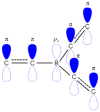Recent Advancement in Boron-Based Efficient and Pure Blue Thermally Activated Delayed Fluorescence Materials for Organic Light-Emitting Diodes
- PMID: 32509723
- PMCID: PMC7248410
- DOI: 10.3389/fchem.2020.00373
Recent Advancement in Boron-Based Efficient and Pure Blue Thermally Activated Delayed Fluorescence Materials for Organic Light-Emitting Diodes
Abstract
In the last few years, electron-deficient materials have been actively researched for application in organic light-emitting diode (OLED) as dopant and electron-transporting materials. The boron-containing materials are interesting as they give good emissive properties in solid state with an electron-accepting character. Recently, many boron-containing materials are used as emissive materials for thermally activated delayed fluorescence (TADF) OLED applications. In this review, boron acceptor-based push-pull small molecules used for application in blue TADF OLEDs are reviewed, covering their different types of acceptor, molecular design, structure-property relation, material properties, and device properties. Also, the importance of boron acceptors to address the key issue of blue TADF OLEDs is discussed.
Keywords: blue organic light-emitting diode (OLED); boron acceptor; electroluminescence; multiple resonance; thermally activated delayed fluorescence (TADF).
Copyright © 2020 Lee, Karthik, Lampande, Ryu and Kwon.
Figures









References
-
- Agou T., Matsuo K., Kawano R., Park I. S., Hosoya T., Fukumoto H., et al. (2020). Pentacyclic ladder-heteraborin emitters exhibiting high-efficiency blue thermally activated delayed fluorescence with an ultrashort emission lifetime. ACS Mater. Lett. 2, 28–34. 10.1021/acsmaterialslett.9b00433 - DOI
-
- Ahn D. H., Kim S. W., Lee H., Ko I. J., Karthik D., Lee J. Y., et al. (2019a). Highly efficient blue thermally activated delayed fluorescence emitters based on symmetrical and rigid oxygen-bridged boron acceptors. Nat. Photonics 13, 540–546. 10.1038/s41566-019-0415-5 - DOI
Publication types
LinkOut - more resources
Full Text Sources
Other Literature Sources

